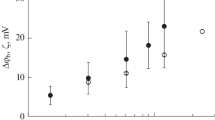Summary
The protoplasmic drop isolated fromNitella became electrically excitable in an appropriate salt solution. Variations of salt composition and temperature in the external media induced discrete changes in the interfacial properties such as refractive index or surface tension, as well as in the electrical properties of the protoplasmic drop. Variation of salt composition was performed by changing the concentration of the respective component at a time from the original test solution (0.5mm NaCl, 0.5mm KNO3, 1mm Ca(NO3)2, and 2mm Mg(NO3)2) with other components being fixed. The following results were obtained: (1) An increase of concentration of univalent cation (Na+ or K+) induced a sharp rise of the refractive index from 1.42 to 1.58 at about 10mm, which was accompanied by a discrete depolarization of the membrane potential of the drop. Fluctuation of reflected light was observed at the critical concentration. (2) The refractive index remained at low values of about 1.42 in Ca2+ concentration ranging between about 0.1 and 10mm. Beyond this concentration range of Ca2+, i.e., both lower and higher, the refractive index increased discontinuously to the value of about 1.58. (3) An addition of multi-valued cations in the test solution led to an abrupt depolarization of the membrane potential at a definite concentration for each ion species. The critical salt concentration dependent strongly on thevalence of cations added, and gave the following series: Th4+<La3+<Ba2+, Sr2+<Na+. (4) Lowering of the surrounding temperature induced an abrupt depolarization of the membrane potential when the Ca2+ concentration in the external solution was close to the lower critical concentration, i.e. 0.1mm. (5) A rise in temperature led to an increase of fluctuations of the membrane potential with frequent outbreaks of small spike potentials, which were followed by an abrupt depolarization. At the same time the tension at the surface decreased discontinuously from 10−1 dynes/cm to the order of 10−4 dynes/cm. All these changes were reversible.
These results imply that the surface membrane of the protoplasmic drop is liable to change its structure in response to the variation of temperature, salt composition in the external media and/or electrical stimulus. Drastic variations of membrane properties such as surface tension, membrane potential and membrane resistance are discussed in connection with the structural change determined by the refractive index measurements.
Similar content being viewed by others
References
Dorsey, N.E. 1928. A new equation for the determination of surface tension from the form of a sessile drop or bubble.J. Wash. Acad. Sci. 18:505
Howarth, J.V., Keynes, R.D., Ritchie, J.M. 1968. The origin of the initial heat associated with a single impulse in mammalian non-myelinated nerve fibres.J. Physiol. 194:745
Huang, C., Thompson, T.E. 1965. Properties of lipid bilayer membranes separating two aqueous phases: Determination of membrane thickness.J. Mol. Biol. 13:183
Inoue, I., Ishida, N., Kobatake, Y. 1973. Studies of excitable membrane formed on the surface of protoplasmic drops isolated fromNitella. IV. Excitability of the drop membrane in various compositions of the external salt solution.Biochim. Biophys. Acta 330:27
Inoue, I., Ishima, Y., Horie, H., Takenaka, Y. 1971. Properties of excitable membrane produced on the surface of protoplasmic drop inNitella.Proc. japan Acad. 47:549
Inoue, I., Kobatake, Y., Tasaki, I. 1973. Excitability, instability and phase transitions in squid axon membrane under internal perfusion with dilute salt solutions.Biochim. Biophys. Acta 307:471
Inoue, I., Ueda, T., Kobatake, Y. 1973. Studies of excitable membrane formed on the surface of protoplasmic drops isolated fromNitella: I. Conformation of surface membrane determined from the refractive index and from enzyme actions.Biochim. Biophys. Acta 298:653
Kamiya, N., Kurada, K. 1957. Cell operation inNitella. I. Cell amputation and effusion of the endoplasm.Proc. Japan Acad. 33:149
Kamiya, N., Kurada, K. 1958. Cell operation inNitella. IV. Tension at the surface of the effused endoplasmic drops.Proc. Japan Acad. 34:435
Miyake, M., Inoue, I., Kobatake, Y. 1973. Studies of excitable membrane formed on the surface of protoplasmic drops isolated fromNitella. III. Impedance of the surface membrane.Biochim. Biophys. Acta 323:369
Tasaki, I. 1968. Nerve Excitation. Charles C. Thomas, Springfield, Ill.;also, Kobatake, Y., Tasaki, I., Watanabe, A. 1971. Phase transition in membrane with reference to nerve excitation.Advanc. Biophys. 2:1
Ueda, T., Inoue, I., Kobatake, Y. 1973. Studies of excitable membrane formed on the surface of protoplasmic drops isolated fromNitella. II. Tension at the surface of protoplasmic drops.Biochim. Biophys. Acta 318:326
Rights and permissions
About this article
Cite this article
Ueda, T., Muratsugu, M., Inoue, I. et al. Structural changes of excitable membrane formed on the surface of protoplasmic drops isolated fromNitella . J. Membrain Biol. 18, 177–186 (1974). https://doi.org/10.1007/BF01870110
Received:
Issue Date:
DOI: https://doi.org/10.1007/BF01870110




